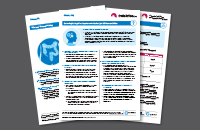 Full Guidelines
Full Guidelines
Click here to view article

 Tools
Tools


 Additional Documents
Additional Documents
Click here to see additional documents

Summary of recommendations for clinicians and policy-makers
This Canadian Task Force on Preventive Health Care guideline on tobacco smoking cessation applies to non-pregnant adults aged 18 years or older who currently smoke tobacco cigarettes. This includes those who smoke regularly or occasionally and those motivated or not motivated to quit.
Key Recommendations
- As part of good clinical care, providers are expected to be knowledgeable about their patients’ smoking status. We recommend that all people who smoke tobacco cigarettes be encouraged to stop and be offered one or more recommended smoking cessation interventions (strong recommendation, high certainty).
- Individuals who smoke should be engaged in shared decision-making about options to support quitting. This involves a collaborative process to help people make choices that align with evidence and their own values and preferences
- We recommend several behavioural, pharmacotherapy, and combined intervention options (strong recommendation):
- Behavioural (low to high certainty of effect estimates across interventions)
- Advice or education from a healthcare provider
- Individual or group counselling from a trained tobacco cessation counsellor
- Mobile phone text message-based interventions
- Self-help materials
- Pharmacotherapy (low to moderate certainty of effect estimates across interventions)
- Bupropion
- Cytisine
- NRT
- Varenicline
- Combined pharmacotherapy and behavioural approaches (low certainty of effect estimates)
- We suggest that interactive computer-based or online programs with additional behavioural support may also be considered (conditional recommendation, very low certainty of effect estimates).
- We recommend against several alternative interventions (strong recommendation, very low to low certainty of effect estimates across interventions):
- Acupuncture
- Continuous auricular stimulation (using indwelling needles or other means to apply continuous stimulation to the auricle)
- Hypnotherapy
- Laser therapy (applying low level lasers to specific anatomical locations)
- Electrostimulation (applying electrical current to specific anatomical locations on the head)
- S-Adenosyl-L-Methionine (SAMe)
- St. John’s wort
- We suggest against using interactive computer-based or online programs without additional behavioural support (i.e., those only involving interaction between the individual and a website or app) (conditional recommendation, very low certainty of effect estimates).
- We suggest against using e-cigarettes for smoking cessation except in certain circumstances (conditional recommendation, low certainty of effect estimate).
- For people who have unsuccessfully attempted other interventions, are otherwise unwilling to try other interventions, or express a strong preference, practitioners may engage in shared decision-making regarding the possible use of e-cigarettes with or without nicotine.
- People who decide to use e-cigarettes to quit smoking should be informed of the uncertainties related to e-cigarettes. These include the lack of approved therapeutic products with consistent formulations, the lack of long-term safety data, and that ongoing use of e-cigarettes with nicotine does not address their addiction to nicotine since it would continue to be consumed.
Addressing tobacco-related inequities likely requires coordinated efforts across a broader range of stakeholders to ensure that those facing the greatest disparities receive effective support to quit smoking. Accordingly, this guideline may also be relevant beyond primary care (e.g., public and policymakers). Recommendations apply to commercial tobacco cigarettes (including hand-rolled) intended for individual use, regardless of origin, and exclude traditional or ceremonial use.
Methodology and Evidence
Systematic reviews were conducted to assess the benefits and harms of smoking cessation interventions, including a review on e-cigarettes and an overview of Cochrane reviews on behavioural, pharmacological, and other approaches.
- Both behavioural and pharmacological approaches increase smoking cessation: combined pharmacologic and behavioural approaches (52 RCTs), brief advice (26 RCTs), individual (27 RCTs) or group (9 RCTs) counselling from a trained counsellor delivered in person or by telephone, mobile phone SMS interventions (12 RCTs), self-help materials (24 RCTs), bupropion (4 RCTs), cytisine (2 RCTs), NRT (8 RCTs), and varenicline (27 RCTs).
- Twelve RCTs suggest that nicotine-containing e-cigarettes may offer a small to moderate cessation benefit at 6-month follow-up compared to non-nicotine e-cigarettes or no intervention, when both groups receive behavioural support or have access to NRT. Non-nicotine e-cigarettes may provide a small benefit.
- Evidence on harm identified:
- Most behavioural interventions either had no harms identified or were associated with little to no harm.
- Bupropion and cytisine may cause little to no increase, or a small increase, in adverse events.
- NRT likely causes a small increase in palpitations or chest pain, with little to no other harms.
- Varenicline is associated with a small increase in adverse events.
- E-cigarettes were associated with little no harm over the short term, but long-term data on harms of using e-cigarettes is not available, and studies showed many people continue using them long term after quitting smoking.
Rationale
- Unsuccessful quit attempts and continued smoking cause ongoing harm due to prolonged tobacco exposure.
- For behavioural interventions, while most benefit data were low certainty, consistent positive effects across similar interventions strengthen our confidence, and there were little to no harms identified and favourable feasibility, acceptability, and equity considerations.
- Pharmacotherapies are also strongly recommended; they offer low-to-moderate certainty of benefit, with small but important harms, outweighed by the significant harms of continued smoking.
- E-cigarettes are conditionally not suggested for most individuals due to a number of important uncertainties, including lack of long-term data on potential harms. However, e-cigarettes may help some people quit, and there are well-established harms of continued smoking. We acknowledge that e-cigarettes could be an option for some, when unwilling to use other options.
- Other therapies have very low-certainty evidence, or show little to no benefit, and some adverse effects. A strong recommendation is made against their use.
Additional Documents
- Clinician Summary
- Systematic Review Protocol
- Overview of Systematic Reviews
- Systematic Review (e-cigarettes)
- Excluded Studies for the Overview of Systematic Reviews (pdf)
- Excluded Studies for the Systematic Review (e-cigarettes) (pdf)
- Reviewers’ Comments (pdf)
- Patient Preferences Data Summary Report (Phase 1, pdf)
- TF-PAN Community Jury: Data Summary Report (pdf)
- CMAJ Author Podcast
- Guideline Presentation
Recommendations do not apply to traditional or ceremonial tobacco use by Indigenous groups or to pregnant or breast/chest-feeding people.
ECRI Evaluation Scores
ECRI Guidelines Trust scores guidelines based on their adherence to the National Academy of Medicine Standards for Trustworthy Guidelines. Find the ECRI evaluation scores for this guideline here.
When the temporary pause of the work of the Task Force was announced in March 2025, some guidelines, such as the Recommendations on interventions for tobacco smoking cessation in adults in Canada, had already undergone stakeholder review and were submitted for publication. These finalized guidelines will continue through the publication process as per guidance from the Public Health Agency of Canada.



